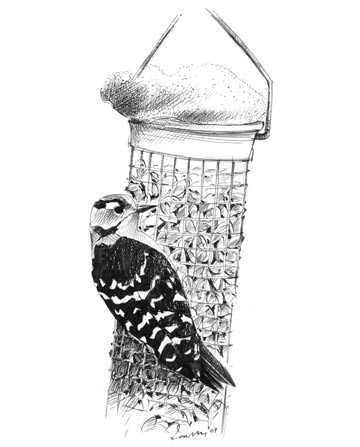
Lesser Spotted Woodpecker © Ray Scally
This Atlas showed that Lesser Spotted Woodpeckers occupied the same number of tetrads in the two seasons but with only 34 having birds present in both, with 58 having breeding season presence only and 57 holding a bird only in winter. Some of this could be the effect of visibility; this is an inconspicuous species, spending much of its time near the treetops and requiring some luck for observers to detect it. Previous authors make the same point, Hardy (1941) describing it as widely distributed but often overlooked, and Bell (1962) echoing those comments and adding that the species had been scarcer in the north but ‘now the chances of finding a bird in the north or east appear to be as great as in the south or west of the county’. The winter map shows that Lesser Spotted Woodpeckers are widely scattered, with a big gap in the centre of Cheshire and in the eastern hills, but appearing to have small concentrations in south Wirral, around Knutsford, and Crewe and Nantwich.
Based on studies in Sweden, Lesser Spotted Woodpeckers are solitary outside the breeding season, and these Atlas observations bear that out, with 108 of the 112 winter records of single birds. Just four records were of two together, at least one of which was identified as a pair in February, probably preparing for the forthcoming breeding attempt. Birds roam about a very large home-range, centred on their breeding territory and probably covering several hundreds of hectares, more than one tetrad (Wiktander et al 2001b).
In winter, the submitted habitat codes showed most (63%) records in woodland, but with a reduction from the breeding season and a shift to farmland (20%) and human sites (14%). There were noticeably fewer records from carr woodland, just four compared to 11 in the breeding season, and with fewer in scrub as well, hinting that some birds quit these areas for the winter. An alternative suggestion, that observers did not visit these rather unwelcoming habitats as often in winter, does not hold good: for all species there were 465 records from the three categories of waterlogged woodland (A4, A5 and A6) in the breeding season and 411 in winter, not significantly different.
Their winter food is mainly longhorn beetles, adults and larvae, found beneath the bark of dead wood, and this species feeds during winter mainly on thin dead branches. In general, the volume of dead wood in British woods is increasing as many areas are left relatively unmanaged, but Lesser Spotted Woodpeckers do not seem to be benefiting. A possible explanation is that the types of dead wood that are increasing in these woods (large dead limbs and dead wood on the ground) are not favoured foraging habitats for this species. It is also possible, but not proven, that they are now less able to coexist with the high numbers of Great Spotted Woodpeckers principally because of nest-site interference and competition (Smith 2007).
Sponsored by Peter Day

